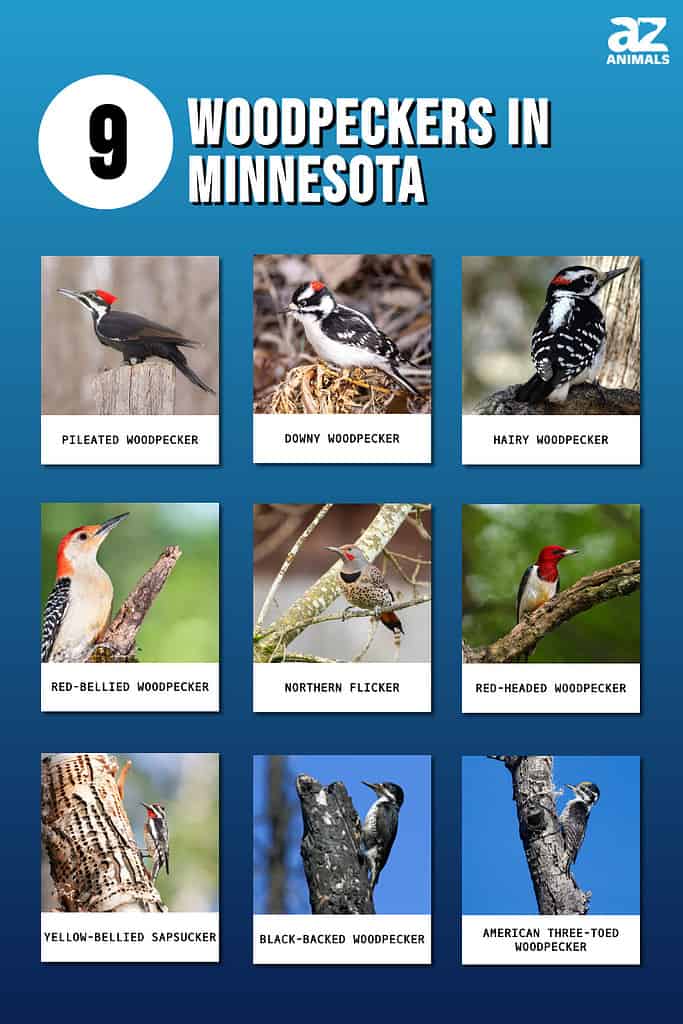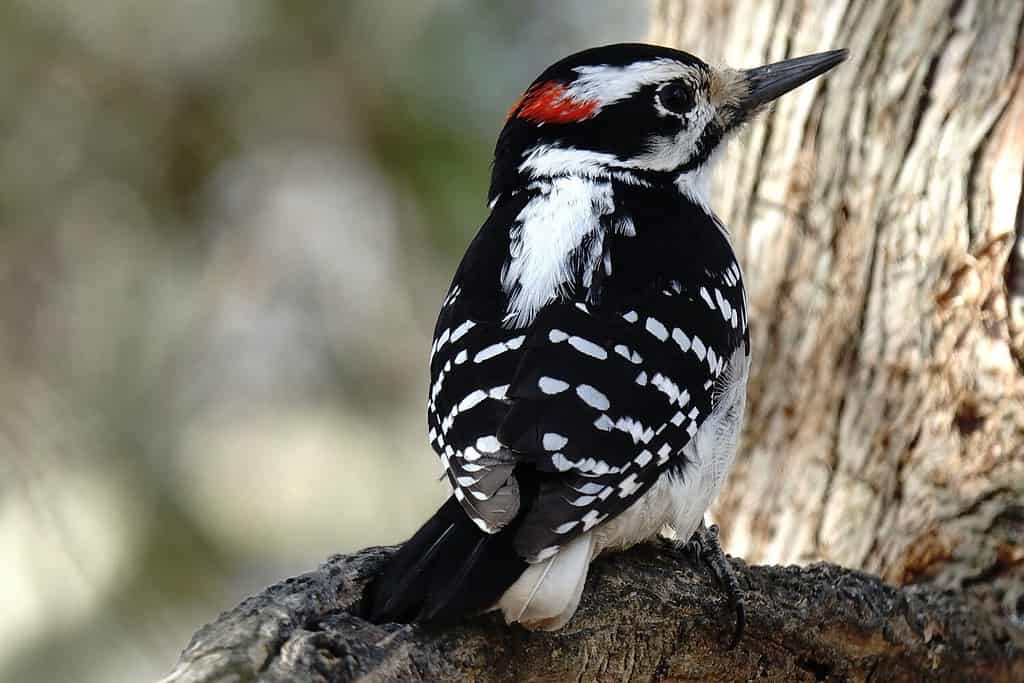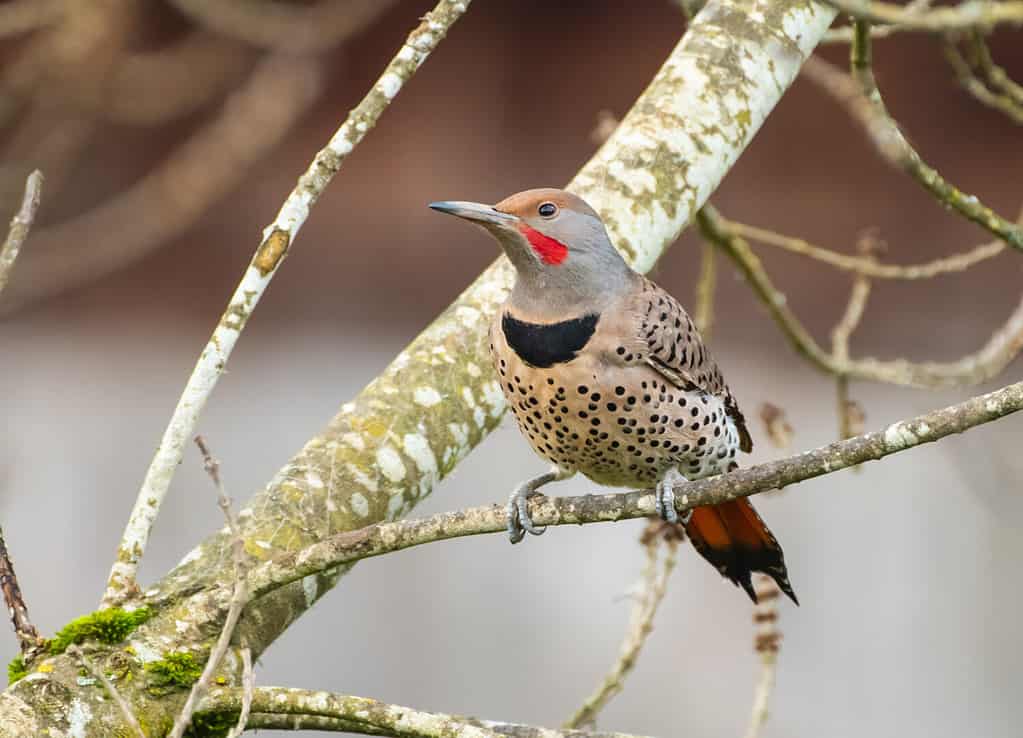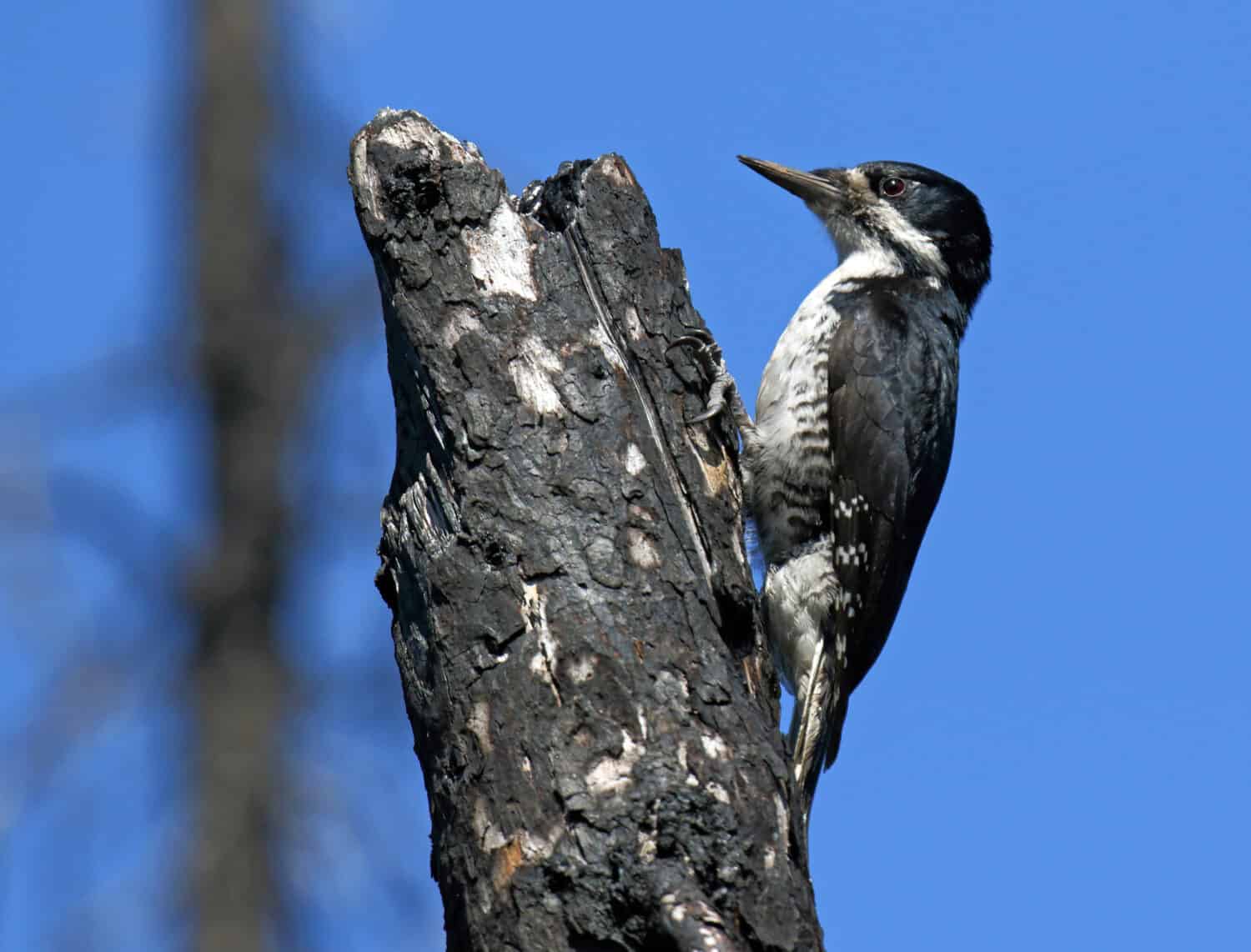Welcome to our comprehensive guide on the woodpeckers in Minnesota! In this article, we will showcase stunning pictures, provide an easy-to-use identification guide, and reveal common locations where you can spot these fascinating birds. Get ready to be amazed by the vibrant woodpecker species residing in the beautiful state of Minnesota.
Certain birds in Minnesota are brave enough to brave the cold winter and remain in the north. These hardy birds, including woodpeckers, are active in mid-to-late winter, making their distinctive drumming calls by repeatedly hitting trees with their beaks. This sound is a sign of the warmth and life of spring coming soon before other birds have even started to make their migrations back north. Nine woodpecker species exist in Minnesota, and they all stay for the winter.

1. Pileated Woodpecker

Of the woodpeckers in Minnesota, the pileated woodpecker is the largest.
©Vlad G/Shutterstock.com
The pileated woodpecker is an impressive-looking bird that is native to North America. It has a large, black body with a bright red crest on its head. Its wingspan can reach up to 40 inches. It weighs around 16 ounces.
The pileated woodpecker has loud, distinctive vocalizations. They are very loud, and you can often hear them up to a mile away. These woodpeckers also make a loud “drumming” sound, which they use for communicating and establishing their territory.
The pileated woodpecker most commonly lives in forests with mature, dead, or dying trees. These provide the perfect habitat for foraging for wood-boring insects. It also likes to nest in wooded parks and gardens.
To see a pileated woodpecker in Minnesota, head to the Chippewa National Forest. This is one of the best places in the state to spot these birds. Other areas where you can see them include Voyageurs National Park and the Minnesota Valley National Wildlife Refuge.
2. Downy Woodpecker

This lovely black and white bird is one of nine woodpeckers in Minnesota.
©J Edwards Photography/Shutterstock.com
The downy woodpecker is a small, black-and-white bird with a white back and a white stripe running from the beak to the back of the head. It has a black tail and a white belly. Its wings are black with white spots, and it has a short, stubby beak.
Downy woodpeckers eat various insects, mostly beetles and wood-boring larvae. They also eat tree sap and fruit. They usually nest in dead trees or dead branches of living trees.
Downy woodpeckers live in deciduous and coniferous forests, woodlots, and suburban areas. In Minnesota, you can see them in the northern and central parts of the state. You may also spot them nesting in parks and backyards.
Overall, the downy woodpecker is a common and widespread bird in North America and is easy to spot. With its distinctive chik-chik sound that makes them easy to hear.
3. Hairy Woodpecker

The black and white speckles of the hairy woodpecker are a joy to spot while birdwatching.
©Carl Reader/Shutterstock.com
The hairy woodpecker is a large woodpecker that is native to North America. It has a black and white barred back and wings and a white head with a black collar and a red patch on the back of its head. It measures 10 inches in length with a wingspan of 15 inches.
The hairy woodpecker’s diet consists mainly of insects, nuts, and berries. It also feeds on larvae, sap, and eggs of other birds. Its vocalizations consist of a loud, ringing call and a softer “churr” sound.
The hairy woodpecker lives in deciduous forests, coniferous forests, and urban areas. In Minnesota, the best places to see a hairy woodpecker are parks, woodlands, and forests. Look for this bird in areas with large trees, such as the St. Croix State Park or the Chippewa National Forest.
4. Red-Bellied Woodpecker

As confusing as the red-colored head may be, the red-bellied woodpecker does, in fact, have a red belly.
©rck_953/Shutterstock.com
The red-bellied woodpecker is a striking bird with a black body, white wings, and a red cap. The male has a bright red neck and belly, and the female has a duller red neck and belly. This bird likes to eat insects, nuts, and fruits. It also sometimes feeds on tree sap.
The red-bellied woodpecker has a loud, rolling call that sounds like “churr-churr” and a drumming sound that you can hear from a distance. It prefers open woods and wooded edges, but it also nests in suburban areas.
In Minnesota, you can find red-bellied woodpeckers in many places, including parks, wooded areas, and open fields. If you are lucky, you might even spot one searching for food in your backyard. They used to live only in the bottom two-thirds of Minnesota, but thanks to climate change, they are making their way north.
5. Northern Flicker

The spotted plumage of the northern flicker makes them one of the most beautiful woodpeckers in Minnesota.
©Jennifer Bosvert/Shutterstock.com
The northern flicker (Colaptes auratus) is a beautiful North American woodpecker. It boasts a distinctive black and white barred back, a black tail with white tips, and a bright red patch under its beak. A medium-sized bird, they range in size from 11-14 inches in length and have a wingspan of 16-20 inches.
These birds typically dine on insects, larvae, and fruits; you will often see them on the ground hunting for food. Northern flickers prefer open woodlands and areas with trees, such as wooded residential areas and parks.
Northern flickers migrate seasonally, with some populations moving south in the winter and others remaining in the same area year-round.
In Minnesota, northern flickers nest in both residential and wooded areas. Birdwatchers typically find them in St. Paul, Minneapolis, and the surrounding suburbs.
6. Red-Headed Woodpecker

The red-colored head gives this woodpecker its name.
©vagabond54/Shutterstock.com
The red-headed woodpecker is a striking and unique bird, easily recognizable by its bright red head. Measuring approximately seven inches long with a wingspan of fourteen inches, the red-headed woodpecker has a black back, white belly, and white wing patches.
Their diet consists of insects, grubs, fruits, and nuts. They also enjoy suet and will come to bird feeders. During the breeding season, they forage on trees and shrubs.
Red-headed woodpeckers make distinctive vocalizations, which sound like a loud, high-pitched “pik-pik-pik” call.
The red-headed woodpecker lives in open woodlands, parks, and suburban areas. Unfortunately, their population in Minnesota has been declining due to habitat loss. They prefer to nest in dead trees, and large portions of their nesting trees were removed in recent years, leaving them with nowhere to live.
If you want to see a red-headed woodpecker in Minnesota, your best bet is to go to a park or wildlife refuge in the southern part of the state. In winter, they head even farther southward. Look for them in open woodlands, perching on trees and shrubs. You might even be lucky enough to spot one at a bird feeder.
7. Yellow-Bellied Sapsucker

While sap is not the only thing yellow bellies eat, it accounts for a significant proportion of their diet.
©Dennis W. Donohue /Shutterstock.com
The yellow-bellied sapsucker (Sphyrapicus varius) is a species of woodpecker that lives all across North America. It has a distinctive appearance, featuring a black and white barred back, white breast, and a yellow patch on its belly. Its wings are black and white with red patches near the shoulders.
The yellow-bellied sapsucker is a migratory bird, spending the warm months in Canada and the northern United States and migrating south to the southern United States and Mexico during the winter. In Minnesota, these birds return at the end of March. You will know they are back because they are quite vocal birds that make a repetitive mewing sound.
The yellow-bellied sapsucker primarily eats insects, as well as tree sap and sap-sucking bugs. It uses its bill to create holes in trees to drink the sap and also eats the larvae of sap-sucking bugs that it finds in the trees.
8. Black-Backed Woodpecker

Of the woodpeckers in Minnesota, the black-backed woodpecker is the most likely to live in a bog.
©Agami Photo Agency/Shutterstock.com
The black-backed woodpecker (Picoides arcticus) is a strikingly beautiful bird that is native to North America. This species is unique for its black and white plumage and its red crown and nape. The black-backed woodpecker measures between 9.1 to 10.2 inches in length and has a wingspan of 17.7 inches.
The diet of this species consists of insects, larvae, and spiders. They also eat fruit and nuts, such as acorns and beechnuts. The black-backed woodpecker typically builds its nest in dead trees but can also nest in conifers.
The best place to spot a black-backed woodpecker in Minnesota is the northern boreal forest. Bogs are also a good spot to look for them, as they like to drill holes in tamarack and spruce trees. You will see them in the Superior National Forest, Chippewa National Forest, and the Boundary Waters Canoe Area Wilderness. These birds are generally nesting boreal forests of Canada and Alaska, but they also live in parts of the northern United States.
9. American Three-Toed Woodpecker

This dainty woodpecker has a yellow stripe down the middle of its forehead.
©Jukka Jantunen/Shutterstock.com
The American three-toed woodpecker (Picoides dorsalis) is a small, black-and-white woodpecker measuring about 8 to 9 inches in length. It has a white belly and white stripes running down its back; the wings and tail are black with white spots. Its most distinguishing feature is its yellow crown, which has three black stripes.
The American three-toed woodpecker feeds primarily on insects and larvae. Its vocalizations include a single, loud “pik” call and a “churr” call when it is agitated.
The American three-toed woodpecker lives mainly in coniferous and mixed forests. In Minnesota, you can find them in northern parts of the state, such as the Boundary Waters Canoe Area Wilderness and the Superior National Forest. These birds also live in forests with recent fire activity.
The photo featured at the top of this post is © ilkah/Shutterstock.com
Thank you for reading! Have some feedback for us? Contact the AZ Animals editorial team.







